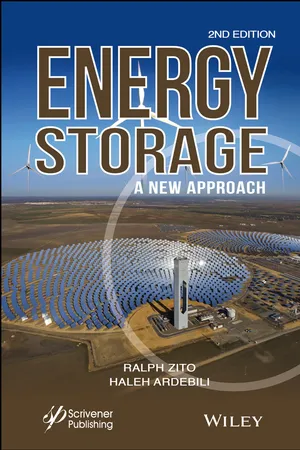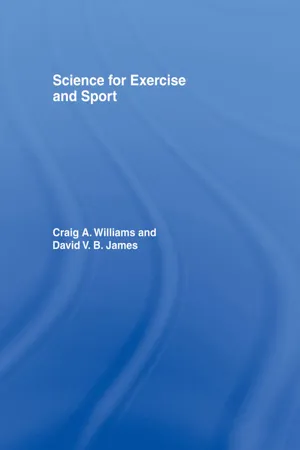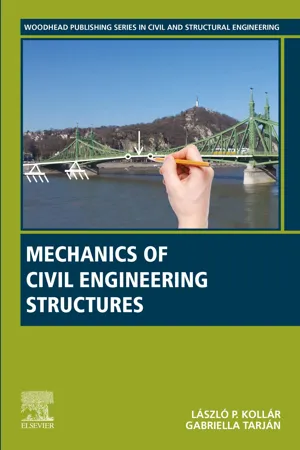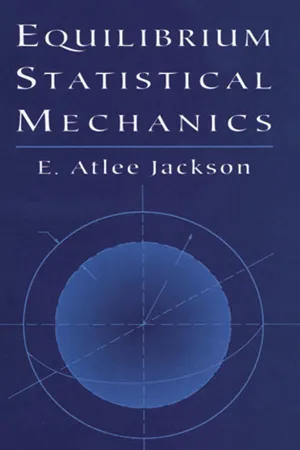Physics
Spring Potential Energy
Spring potential energy is the stored energy in a compressed or stretched spring due to its deformation from its equilibrium position. This energy is potential because it has the potential to do work when the spring is released and returns to its original shape. The amount of spring potential energy is directly proportional to the amount of deformation.
Written by Perlego with AI-assistance
Related key terms
Related key terms
1 of 4
Related key terms
1 of 3
8 Key excerpts on "Spring Potential Energy"
- eBook - ePub
Energy Storage
A New Approach
- Ralph Zito, Haleh Ardebili(Authors)
- 2019(Publication Date)
- Wiley-Scrivener(Publisher)
Humans have been using uncoiled mechanical springs in bows and arrows for thousands of years, for hunting and survival. When using bows and arrows, we are in fact harnessing the elastic potential energy that was stored in the unoiled springs. As time passed, upon the emergence of coiled springs, the usage of mechanical springs expanded to many common applications including watches.Imagine, as you twist the knob on a watch, you are causing the spring to coil, and thus, you are powering the watch with elastic potential energy. The watch would then uncoil, gradually in time, during the operation and thus, release the stored energy. Figure 2.4 shows the schematics of the coiled springs in an Elgin watch that was commonly used from 1864 to 1968.To quantify the potential energy stored in elastic coiled structures such as a spring, we express the elastic energy U as(Courtesy of Elgin National Watch Co.)Illustration of the coiled mainsprings used in Elgin pocket watchFigure 2.4(2.14)where k is the spring constant, and x is the displacement of the spring.For deformable bodies that can undergo deformation d or strain ε (the derivative of displacement with respect to position), the linear elastic strain energy (U) and strain energy density (u) (i.e. energy per volume), can be calculated as(2.15)(2.16)where, F is the force on the body, k is the material stiffness (or spring constant), σ is the stress in the body, and E is the elastic modulus.The strain energy density in one dimension can be converted to 2D or 3D based on the actual state of stresses and strains in the body. For example, if a body is subjected to plane stress (i.e., the normal and shear stresses in a plane are non-zero), the strain energy density (u) is expressed as(2.17)where x and y refer to the directions of the normal stresses and strains, and τxy is the γxy are the shear stress and strain, respectively, in the xy plane.2.2 Electrical Energy
Imagine a charged particle at a certain voltage. The electrical or electrostatic energy (or work) associated with this particle can be calculated by multiplying its charge (in coulomb) by the voltage (in volt):(2.18)Now, imagine two particles with respective charges q1 and q2 - eBook - ePub
- David James, Craig Williams(Authors)
- 2014(Publication Date)
- Routledge(Publisher)
kinetic energy.Potential energy is calculated by multiplying the mass (in kg) of an object by the acceleration due to gravity (in m·s−2 ) acting on the object and the vertical displacement (i.e. height) of the object (in m) (see Equation 6.4 ). Kinetic energy is calculated by dividing the mass (in kg) of an object by 2, and then multiplying by the square of the velocity (in m·s−1 ) (see Equation 6.5 ).The transformation of energy between potential and kinetic forms can also be observed when elastic is stretched and then released. As the elastic is stretched it gains potential energy, which is known as strain energy. The maximal gain in strain energy is reached just before the elastic reaches its elastic limit, otherwise known as the yield point (beyond this point energy is lost and the elastic takes on plastic properties). If the elastic is then released, potential energy is converted to kinetic energy. The change in length of elastic (m) is proportional to the force applied (N), a relationship known as Hooke’s law (see Equation 6.6 ).The gain in strain energy is related to the ability of the elastic to store energy on lengthening (k ) and the change in length of the elastic (x ) (see Equation 6.7 ).The mechanical properties of muscle and connective tissue are very much like those of elastic, except for a damping effect (i.e. a shock absorber effect). In Application 2 at the end of this chapter, the effects of these properties of muscle and connective tissue are examined. Try to investigate the contribution of the elastic properties of the muscle and connective tissue in your own legs by comparing the height jumped with two jumping techniques. First try a vertical jump starting from a crouched position (i.e. with your legs bent). Secondly try a vertical jump starting from a standing position. You will observe that the height jumped using the second technique is greater due to the elastic contribution of the muscle and connective tissue in the legs. Kangaroos make extremely good use of the elastic properties of the tendons in their legs, to the extent that they become slightly more efficient as their speed increases. - eBook - ePub
- Laszlo P. Kollar, Gabriella Tarjan(Authors)
- 2020(Publication Date)
- Woodhead Publishing(Publisher)
h is the vertical location of the mass. We chooseh =h o− u ,(6.23)where h o is the position of the mass, when the spring is undeformed. Since the reference location can be chosen arbitrarily, we state h o = 0. Thus, for the motionless mass, the potential energy is (Fig. 6.6 )π =U︸1 2u 2k.W− Fu︸(6.24)Fig. 6.5 Total energy of a spring-mass system.Fig. 6.6 Potential energy of a spring-mass system.The first term is the strain energy and the second one is the ability of the gravitational force to do work, which is denoted by W . In this example the source of the force was gravitation; however, it could be any other form: electrostatic, wind, etc.We extend now the potential energy to an arbitrary object. The strain energy was already discussed. As we stated earlier, any kind of force has the ability to do work, regardless of the source of the force,c and the work done is equal to the size of the force times the displacement in the direction of the force. For concentrated forces, it is e i F i , while for distributed forces the force times the corresponding displacements must be integrated on the domain of the acting force (Fig. 6.7 ). For an arbitrary 3-D object, the potential energy isπ = U + W ,(6.25)W = −∫ VudV − ∑p x+ vp y+ wp ze iF i,(6.26)where U is given by Eq. (6.14) ; F i are the concentrated loads; e i are displacements in the direction of the forces; p x , p y , and p z are the distributed forces in the x, y , and z direction, respectively; and u , v , and w are the displacements in the three directions.Fig. 6.7 Work done by concentrated and distributed forces.For beams, often moment or moment couple loads are applied (Fig. 6.8 ), and their work can be calculated asW = − φM , W = − θM ˆ(6.27)where φ is the rotation of the cross section where the moment is applied while θ is the relative rotation of the cross sections whereM ˆis applied. The potential energy of a beam is (Eqs. 6.15 , 6.16 , 6.26 , 6.27 - eBook - ePub
Newtonian Dynamics
An Introduction
- Richard Fitzpatrick(Author)
- 2021(Publication Date)
- CRC Press(Publisher)
This is a sure sign that it is possible to associate a potential energy with the spring force. Equation (5.34), which is the basic definition of potential energy, yields U (x B) − U (x A) = − ∫ x A x B f (x) d x = 1 2 k x B 2 − 1 2 k x A 2. (5.40) Hence, the potential energy of the mass takes the form U (x) = 1 2 k x 2. (5.41) Note that the previous potential energy actually represents energy stored by the spring, in the form of mechanical stresses, when it is either stretched or compressed. Incidentally, this energy must be stored without loss, otherwise the concept of potential energy would be meaningless. It follows that the spring force is another example of a conservative force. It is reasonable to suppose that the form of the Spring Potential Energy is somehow related to the form of the spring force. Let us now explicitly investigate this relationship. If we let x B → x and x A → 0 then Equation (5.40) gives U (x) = − ∫ 0 x f (x ′) d x ′. (5.42) We can differentiate this expression to obtain f = − d U d x. (5.43) Thus, in one dimension, a conservative force is equal to minus the derivative (with respect to displacement) of its associated potential energy. This is a quite general result. For the case of a spring force; U = (1 / 2) k x 2, so f = − d U / d x = − k x. As is easily demonstrated, the three-dimensional equivalent to Equation (5.43) is f = − ∇ U ≡ − ∂ U ∂ x, ∂ U ∂ y, ∂ U ∂ z. (5.44) For example, we have seen that the gravitational potential energy of a mass, m, moving above the Earth’s surface is U = m g z, where z measures height above sea level. It follows that the associated gravitational force is f = (0, 0, − m g). (5.45) In other words, the force is of magnitude m g, and is directed vertically downward. The total energy of the mass shown in Figure 5.8 is the sum of its kinetic and potential energies; E = K + U = K + 1 2 k x 2. (5.46) Of course, E remains constant during the mass’s motion - eBook - ePub
Janice VanCleave's Physics for Every Kid
Easy Activities That Make Learning Science Fun
- Janice VanCleave, Tina Cash Walsh(Authors)
- 2021(Publication Date)
- Jossey-Bass(Publisher)
Hz), where 1 Hz = 1 cycle per second or one back and forth vibration.Potential energy is the energy an object has because of its position relative to some zero position. It is energy that has the potential to do ‘work.’ Two types of potential energy investigated in this book are gravitational potential energy and elastic potential energy.- Gravitational potential energy is the stored energy an object has because of its position above a specific ground zero. This type of potential energy is due to the force of gravity acting on the object. To obtain this energy, work had to be done on an object to raise it to a higher level above ground zero, such as placing a book on a top shelf with the floor below being ground zero. Gravitational potential energy is directly related to the mass of the object as well as its height above ground zero. When the book is dropped from a specific height, its gravitational potential energy is converted to kinetic energy as the book falls.
- Elastic potential energy is the energy stored in an object that can be stretched or compressed. A force is needed to compress or stretch an elastic object. Consider a trampoline, which has the greatest elastic potential energy when it is stretched the most, as does a rubber band. A coiled spring stores elastic potential energy when a force compresses it as well as when a force stretches it. In both cases, when the spring is released, the spring's elastic potential energy results in the wound coils moving back to their normal position. Thus, the elastic potential energy is converted to kinetic energy.
Kinetic energy (KE) is the energy of objects that are moving. Remember, kinetic energy does not cause an object to move, instead objects have kinetic energy because they are moving. A ball at the top of a ramp has gravitational potential energy. As the ball rolls down the ramp, its gravitational potential energy is converted to kinetic energy. There are three types of kinetic energy: vibrational, rotational, and translational. Vibrational KE is the energy caused by a back and forth movement; rotational KE is the result of turning about an axis, and translational KE - No longer available |Learn more
- Robert A. Pelcovits, Joshua Farkas(Authors)
- 2023(Publication Date)
- Barrons Educational Services(Publisher)
force constant, is a property of the particular spring. It is a measure of the stiffness of the spring (a spring with a larger spring constant produces larger forces at the same displacement).■The direction of the spring force is opposite the displacement, as indicated by the negative sign. (Because the force always tries to restore the spring to its relaxed state, whether it has been stretched or compressed, it is called a restoring force. We will encounter other restoring forces in Chapter 8 .)Example 4.4 Unit AnalysisWhat are the units of the spring constant k?SolutionFx = −kx. Writing this equation in terms of units,Elastic Potential Energy
In order to obtain an expression for the elastic potential energy stored in a spring, we can take the same approach as we did with gravity: calculate the work as a function of position and then apply the equation W = −ΔU. Suppose that such that the spring lies along the x-axis with its equilibrium position at the origin. How much work is done by the spring force during a given displacement? The force varies, so we must use the differential definition of work this time:Comparison with the definition of potential energy as W = −ΔU reveals thatNote that the above expression for Uelastic requires that x = 0 corresponds to the unstretched state of the spring. Unlike the case of gravitational potential energy where we could choose y = 0 wherever we liked, here we must choose x = 0 at the equilibrium position.Example 4.5A mass attached to a spring starts from rest at equilibrium. A variable external force is exerted on the mass, resulting in stretching the spring by an amount a and accelerating the mass to a speed of vf .(a)What is the work done by the spring force? (b)What is the change in the object’s kinetic energy? (c)What is the work done by the external force?Solution(a)Note that the work done is negative. (As the spring is stretched, the restoring force is antiparallel to the displacement, so the work is negative.) - eBook - ePub
- E. Atlee Jackson(Author)
- 2012(Publication Date)
- Dover Publications(Publisher)
x o) represents the amount the spring is stretched (or compressed), and Hooke’s law says thatF x = − κ (x − x 0 )where κ is called the force constant (see Figure 1 ). The force is always such as to restore the particle to the point x = x o, for F x < 0 if x > x o, whereas F x > 0 if x < x o . However, when the particle reaches the point x o, it has a large velocity so that it overshoots this point. In other words, it oscillates back and forth past x = x o. This system is an example of a harmonic oscillator. The potential energy in this case is [if we take φ (x 0 ) = 0]Figure 1The distinctive feature of a harmonic potential is that it is a quadratic function of (x − x 0 ). The total energy is(11)To verify that ε is constant in time, we first must solve Newton’s equation: The general solution of this equation isas may be verified by direct substitution. The motion is periodic with a period 2π /ω , so the frequency is ν = (1/2π)(κ /m) 1/2 . It is left as an exercise to show that if this solution is substituted into Equation (11), using ν = d x/dt , then ε is in fact a constant.If φ (x) is plotted as a function of x , we obtain a figure like Figure 2 . Sometimes a potential of this shape is referred to as a “potential well” or “potential valley.” At the bottom of the well, where dφ /dx = 0, there is no force on the particle. A particle placed at that point remains there, and it is therefore called the point of mechanical equilibrium. To the right of the equilibrium point, the force is toward the left (F x = − dΦ/dx ), whereas to the left of x 0 the force is directed toward the right (dφ/dx < 0) — like a ball rolling in a bowl shaped like φ - eBook - ePub
Mechatronic Systems, Sensors, and Actuators
Fundamentals and Modeling
- Robert H. Bishop(Author)
- 2017(Publication Date)
- CRC Press(Publisher)
Table 9.4 , where examples are given for the translational and rotational one-port.TABLE 9.4 Mechanical Potential Energy Storage Elements (Integral Form)FIGURE 9.12 Example of two-port potential energy storing element: (a) cantilevered beam with translational and rotational end connections, (b) C-element, 2-port model.The linear translational spring is one in which F = F(x) = kx = (1/C)x, where k is the stiffness and C ≡ 1/k is the compliance of the spring (compliance is a measure of “softness”). As shown in Table 9.4 , the potential energy stored in a linear spring is, and the co-energy is UF = ∫ Fdx = ∫ (F/k) dF = F2 /2k. Since the spring is linear, you can show that Ux = UF . If the spring is nonlinear due to, say, plastic deformation or work hardening, then this would not be true.U x=∫F d x =∫k x d x =1 2kx 2Elastic potential energy can be stored in a device through multiple ports and through different energy domains. A good example of this is the simple cantilevered beam having both tip force and moment (torque) inputs. The beam can store energy either by translational or rotational displacement of the tip. A constitutive relation for this 2-port C-element relates the force and torque to the linear and rotational displacements, as shown in Figure 9.12 . A stiffness (or compliance) matrix for small deflections is derived by linear superposition.9.3.4 Kinetic Energy StorageAll components that constitute mechanical systems have mass, but in a system analysis, where the concern is dynamic performance, it is often sufficient to focus only on those components that may store relevant amounts of kinetic energy through their motion. This presumes that an energetic basis is used for modeling, and that the tracking of kinetic energy will provide insight into the system dynamics. This is the focus of this discussion, which is concerned for the moment with one-dimensional translation and fixed-axis rotation. Later it will be shown how the formulation presented here is helpful for understanding more complex systems.
Index pages curate the most relevant extracts from our library of academic textbooks. They’ve been created using an in-house natural language model (NLM), each adding context and meaning to key research topics.
Explore more topic indexes
Explore more topic indexes
1 of 6
Explore more topic indexes
1 of 4







